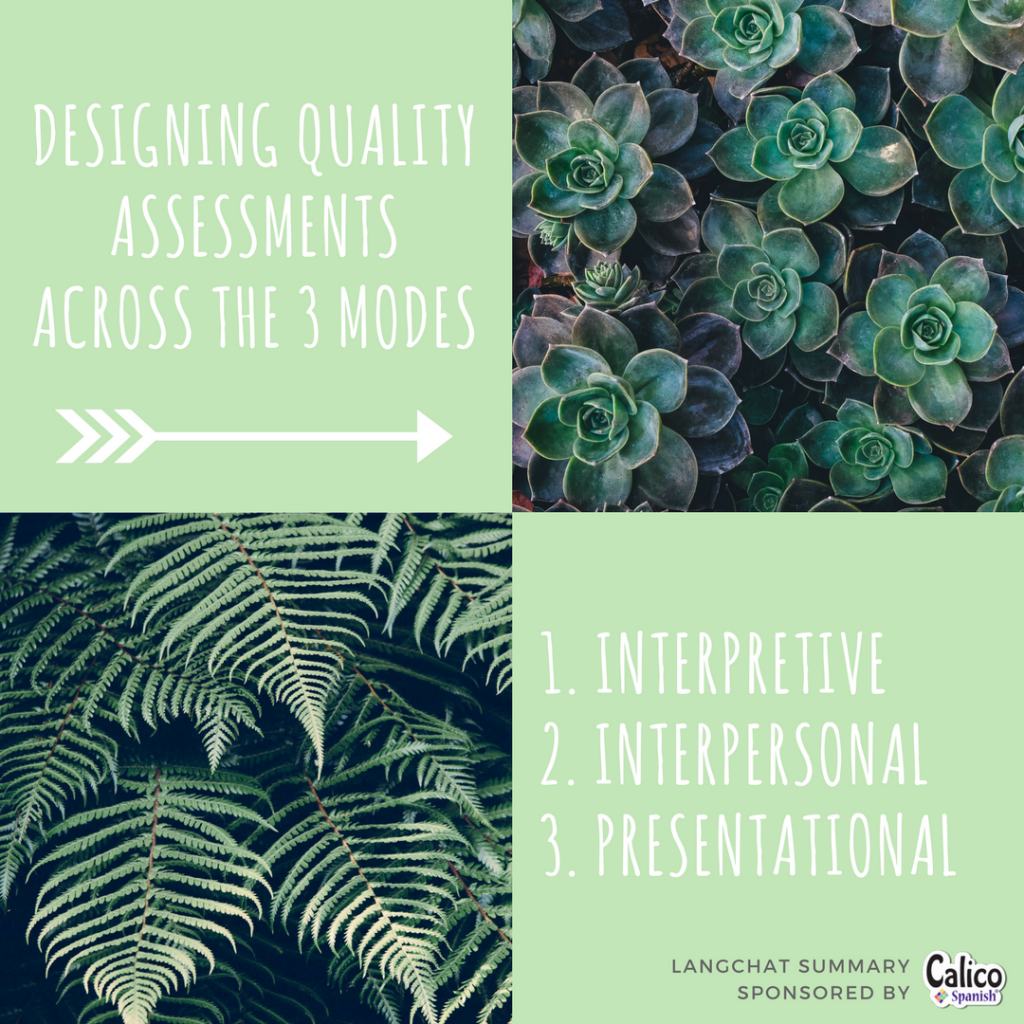Designing quality assessments across the three modes: interpretive, interpersonal, and presentational
This #langchat conversation looked at how to best assess interpersonal, interpretive, and presentational modes in a World Language Classroom. In the course of the discussion, participants also offered ideas on when to design assessments for each mode and worked to identify the important elements in a performance rubric.
– Follow the blog on Bloglovin –
Deciding Which Modes to Assess
 When and how do world language teachers decide which modes to assess? @SECottrell shared, that she “tends to move in a progression: start heavy, heavy on interpretive, start sprinkling in interpersonal, and presentational later.” Many teachers agreed that focusing on interpretive and interpersonal modes first gives a strong foundation when it comes to practicing the presentational mode. @Srta_Zeiner said, “In novice, I focus most on interpersonal and interpretive. Getting [students] speaking and listening right away is key!” For teacher, @joyeuse212, it “depends on the ebb & flow of the class and when the timing is right. More interpretive & interpersonal first. Presentational last.”
When and how do world language teachers decide which modes to assess? @SECottrell shared, that she “tends to move in a progression: start heavy, heavy on interpretive, start sprinkling in interpersonal, and presentational later.” Many teachers agreed that focusing on interpretive and interpersonal modes first gives a strong foundation when it comes to practicing the presentational mode. @Srta_Zeiner said, “In novice, I focus most on interpersonal and interpretive. Getting [students] speaking and listening right away is key!” For teacher, @joyeuse212, it “depends on the ebb & flow of the class and when the timing is right. More interpretive & interpersonal first. Presentational last.”
Important Elements in a Performance Rubric
Langchat participants discussed the elements to include in performance rubrics and in the spirit of proficiency-based teaching, teachers agreed that comprehensibility is the most important element to look for in students’ presentations. @Marishawkins shared, “also after comprehensibility, how students use vocab- so they aren’t as repetitive.” @SraChiles said, “Yes, comprehensibility is #1, but also having details, varied language, & active interaction for an interpersonal rubric” are important.” “Sometimes banning the words bueno/interesante/bonito to force kids to use other vocabulary” is helpful to assessing a variety of language (@Meganclaire87).
– Like Calico Spanish on Facebook –
Tasks and Structures for Interpretive Assessments
World Language teachers discussed the variety of ways in which they use tasks to assess interpretation in their classrooms.
- @SECottrell said, “we turn interpretive text / audio into a multitasking picture: diagraming the story, facts, timeline, etc.”
- @srtabrandt96 assesses through “finding key terms, main ideas, supporting details//at higher levels: inferencing & predictions.”
- @Nathanlutz shared, “deep and close listening using authentic resources (video and strictly audio) on @EDpuzzle, my tech hubby” creates tasks for assessing interpretation.
- @Oraib_Mango uses “mostly multiple choice or true or false to identify main idea and details.”
– Follow Calico Spanish on Twitter –
Tasks and Structures for Interpersonal Assessments
Physically setting up a task for an interpersonal assessment can look different from classroom to classroom. Langchat teachers shared what this can look like with their students. For example, @Magistertalley said, “I have recorded students, also have them record Flipgrid videos of a group. Sometimes it’s just me talking to a student.” @srtabrandt96 is a “big fan of allowing students to have an open dialogue with each other in pairs or groups. It allows freedom & less stress.” “Give students a prompt; they practice with the partners they choose, and randomly pair on day of assessment. Students then talk to each other spontaneously,” shared @Srta_Zeiner.
– Follow us on Instagram too! –
Tasks and Structures for Presentational Assessments
Lastly, #langchat teachers shared structures and tasks for successful presentational assessments.
- @Magistertalley said, “For speaking – Show and Tell, in-class presentations and Flipgrid.”
- @kltharri suggests pechakucha.
- @srtabrandt96 incorporates “some form of research & then [students] show what they learned, or they have to tell a story of some sort.”
- @rlgrandis suggests “having students creating stories, whether writing or recording a story with their drawings on @educreations.”
- @rlgrandis shared, “I am a fan of Google Voice but have started having students record in OneNote for presentational speaking.”
- @GMancuso13 said, “I started using Seesaw for quick [presentational] assessments. I like being able to listen on my own time and give valuable feedback.”
Introduce a child you love to a lifelong journey of speaking real Spanish to real people. Click the red button to experience it FREE.
Thank You
Thanks especially to John Cadena (@CadenaSensei) for moderating! #Langchat official moderators continue to moderate the first and third chats of the month, but be on the lookout for participant teachers to take the initiative to lead many other discussions to come.






No Comments